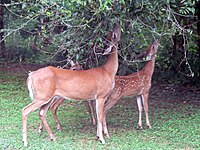
Diet breadth of the aphid predator Chrysoperla rufilabris Burmeister (Neuroptera: Chrysopidae)
Sign Up to like & getrecommendations! Published in 2022 at "Bulletin of Entomological Research"
DOI: 10.1017/s0007485321001061
Abstract: Abstract The performance (development and reproduction) of generalist predators can vary greatly among the prey species that they use, and these differences can influence the ability of predatory insects to suppress pest populations. The aim… read more here.
Keywords: diet breadth; chrysoperla rufilabris; aphid predator; rufilabris burmeister ... See more keywords

Species‐level, but not family‐level diet breadth predicts geographic distribution of Sydney butterflies
Sign Up to like & getrecommendations! Published in 2019 at "Insect Conservation and Diversity"
DOI: 10.1111/icad.12388
Abstract: Diet specialisation drives life‐history adaptations and is an important factor determining the geographic distribution of species. Previous empirical studies have shown that diet specialists should compose the majority of species in a given location, and… read more here.
Keywords: sydney butterflies; diet breadth; family level; geographic distribution ... See more keywords

Across Multiple Species, Phytochemical Diversity and Herbivore Diet Breadth Have Cascading Effects on Herbivore Immunity and Parasitism in a Tropical Model System
Sign Up to like & getrecommendations! Published in 2018 at "Frontiers in Plant Science"
DOI: 10.3389/fpls.2018.00656
Abstract: Terrestrial tri-trophic interactions account for a large part of biodiversity, with approximately 75% represented in plant–insect–parasitoid interactions. Herbivore diet breadth is an important factor mediating these tri-trophic interactions, as specialisation can influence how herbivore fitness… read more here.
Keywords: herbivore; plant; diet breadth; herbivore immunity ... See more keywords

Diet Breadth Affects Bacterial Identity but Not Diversity in the Pollen Provisions of Closely Related Polylectic and Oligolectic Bees
Sign Up to like & getrecommendations! Published in 2020 at "Insects"
DOI: 10.3390/insects11090645
Abstract: Simple Summary Solitary bees are important pollinators in managed and wild ecosystems. Across the bee phylogeny, bees may forage on a single species of plant, few plant species, or a broad diversity of plants. During… read more here.
Keywords: diversity; diet breadth; breadth affects; bee ... See more keywords